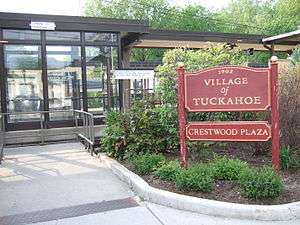Crestwood station
The Crestwood station is a commuter rail stop on the Metro-North Railroad's Harlem Line, serving the communities of Tuckahoe, Yonkers, and Eastchester, New York. It is 16.7 miles (26.9 km) from Grand Central Terminal and travel time there is approximately 42 minutes. Because of its location at the northern end of the triple-track segment of the Harlem Line, Crestwood is often the first/last stop outside New York City on Harlem Line express trains, and its center island platform is frequently used to short turn local trains during rush hour.
Crestwood | |||||||||||
|---|---|---|---|---|---|---|---|---|---|---|---|
 Tuckahoe Village/Crestwood Plaza sign along the Wassaic-bound platform. | |||||||||||
| Location | 1 Columbus Avenue, Tuckahoe, New York | ||||||||||
| Coordinates | 40.9590°N 73.8209°W | ||||||||||
| Line(s) | Harlem Line | ||||||||||
| Platforms | 1 island platform 1 side platform | ||||||||||
| Tracks | 3 | ||||||||||
| Construction | |||||||||||
| Parking | 283 spaces | ||||||||||
| Disabled access | Yes | ||||||||||
| Other information | |||||||||||
| Fare zone | 3 | ||||||||||
| History | |||||||||||
| Opened | 1901 | ||||||||||
| Rebuilt | 1911, 1928, 1971, 1989 | ||||||||||
| Electrified | 700V (DC) third rail | ||||||||||
| Previous names | Yonkers Park | ||||||||||
| Traffic | |||||||||||
| Passengers (2007) | 501,904 | ||||||||||
| Services | |||||||||||
| |||||||||||
| Former services | |||||||||||
| |||||||||||
The Harlem Line has two stations in the village of Tuckahoe. Tuckahoe station, the next station heading southbound, is located near Tuckahoe Village Hall, while Crestwood is located near the adjoining residential neighborhood of Crestwood, Yonkers.
As of August 2006, daily commuter ridership was 1,596, and there are 283 parking spots.[1] This station is the first/last station in the Zone 3 Metro-North fare zone.
History
Originally built by the New York Central Railroad sometime in 1901, the station's canopy was rebuilt in 1911, then faced a major redesign in 1928.[2] The Crestwood railroad station is depicted in the painting "Commuter" by Norman Rockwell and was featured on the cover of the November 16, 1946 edition of the Saturday Evening Post.[3] In Norman Rockwell's depiction, you can see commuters approaching from the Crestwood side of the station. As with the rest of the Harlem Line, the merger of New York Central with Pennsylvania Railroad in 1968 transformed it into a Penn Central station, which received platform extensions in 1971.[4]
Penn Central commuter service was gradually merged with the Metropolitan Transportation Authority (MTA), and officially became part of Metro-North in 1983. In the Spring of 1989, the platforms were reconstructed again, along with those of Fleetwood, Bronxville, and Tuckahoe stations.[5] Under the 2015–2019 MTA Capital Plan, the station, along with four other Metro-North Railroad stations, would receive a complete overhaul as part of the Enhanced Station Initiative. Updates would include cellular service, Wi-Fi, USB charging stations, interactive service advisories, and maps.[6] The renovations at Crestwood station will cost $10.6 million and will be completed by the end of October 2019.[7]:62
Station layout
This station has two slightly offset high-level platforms each 12 cars long.[8]:10 Parking at the station is available on Columbus Avenue halfway between Fisher Avenue and Lincoln Avenue along the northbound platforms, and off of the Thompson Street interchange of the Bronx River Parkway along the southbound platforms.
| M | Mezzanine | Crossover between platforms, exit/entrance, parking |
| P Platform level |
Track 4 | ← Harlem Line toward Grand Central (Tuckahoe) |
| Island platform, doors will open on the left or right | ||
| Track 2 | ← Harlem Line toward Grand Central (Tuckahoe) Harlem Line toward North White Plains (Scarsdale) → ← Harlem Line express service does not stop here → | |
| Track 1 | Harlem Line toward North White Plains (Scarsdale) → | |
| Side platform, doors will open on the right | ||
References
- New York Times 2006 Metro-North commuuter rail info
- Crestwood Railroad Station (Library of Congress: American Memory, Page 4)
- Hershenson, Roberta (December 19, 1993). "Uncertain Future of a Cherished Station". The New York Times. Retrieved 2009-08-15.
- Crestwood Railroad Station (Library of Congress: American Memory, Page 5)
- Harlem Line Schedule History (iRide the Harlem Line)
- "Metro-North Railroad to Make Design Improvements to Five Stations Under Enhanced Stations Initiative Program". MTA. 2017-12-14. Retrieved 2017-12-17.
- "Capital Program Oversight Committee Meeting" (PDF). Metropolitan Transportation Authority. May 20, 2019. Retrieved May 19, 2019.
- "Metro-North Railroad Track & Structures Department Track Charts Maintenance Program Interlocking Diagrams & Yard Diagrams 2015" (PDF). Metro-North Railroad. 2015. Retrieved January 28, 2019.